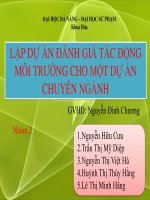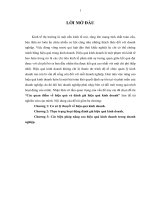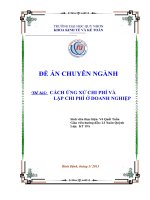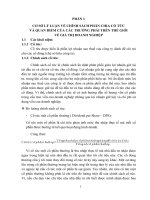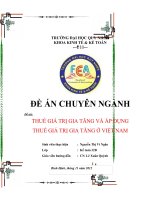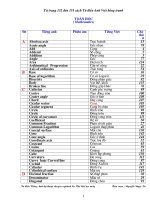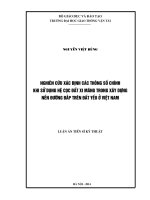tiếng anh chuyên ngành quản lý bán hàng và tiếp thị
Bạn đang xem bản rút gọn của tài liệu. Xem và tải ngay bản đầy đủ của tài liệu tại đây (916.53 KB, 78 trang )
Hợp tác gi ữa Nhà Xuất Bản Gi áo Dục Việt Nam và Mạng đào tạo BEA.VN
Bản quyền của Nhà Xuất Bản Giáo Dục Việt Nam
Nghiêm cấm sao chép dưới mọi hình thức
1
Hợp tác gi ữa Nhà Xuất Bản Gi áo Dục Việt Nam và Mạng đào tạo BEA.VN
ĐINH ĐỨC HÙNG(Chủ biên)
NGUYỄN TIẾN DŨNG
ENGLISH FOR MARKETING AND SALES
Cố vấn chương trình
: Nguyễn Quốc Hùng M.A
Biên soạn
: Nguyễn Tiến Dũng M.A
Bản quyền của Nhà Xuất Bản Giáo Dục Việt Nam
Nghiêm cấm sao chép dưới mọi hình thức
2
Hợp tác gi ữa Nhà Xuất Bản Gi áo Dục Việt Nam và Mạng đào tạo BEA.VN
Bản quyền của Nhà Xuất Bản Giáo Dục Việt Nam
Nghiêm cấm sao chép dưới mọi hình thức
3
Hợp tác gi ữa Nhà Xuất Bản Gi áo Dục Việt Nam và Mạng đào tạo BEA.VN
Công ty cổ phần Đầu tư và Phát triển Giáo dục Hà Nội
Nhà xuất bản Giáo dục Việt Nam giữ quyền công bố tác phẩm
243 – 2011/CXB/23 – 253/GD
Mã số: 7X397K1
Lời giới thiệu
Trên con đường tiếp thu kiến thức và rèn luyện kỹ năng khơng phải ai cũng có điều
kiện học mặt đối mặt (face-to-face learning), nghĩa là đến trường, đến lớp. Học từ xa
(distance learning, e-learning) là một hình thức phổ biến trong thế giới hiện đại. Với
e-learning, những nhà tổ chức giáo dục có điều kiện xây dựng một cộng đồng học tập
trên mạng, tạo điều kiện cho đông đảo người học theo đuổi được mục tiêu học thuật
của mình. Với hình thức học tập này, trong giới giáo học pháp dạy-học ngoại ngữ
thường nói: Learn a language without a teacher! In the comfort of your own home! All
the language skills you will ever need! (Học một ngơn ngữ khơng có giáo viên! Học
ngay tại nhà! Tiếp nhận được tất cả các kỹ năng bạn luôn luôn cần đến!)
Điều thách thức đối với e-learning là sự kiên trì và phương pháp. Chúng ta có thể nói
một cách dễ dàng: mỗi ngày chỉ cần học 60 phút; nhưng không phải ai cũng làm được
việc này trong một thời gian dài, ví dụ một năm. Phương pháp học ngoại ngữ đòi hỏi
sự tỉ mỉ từng bước, ví dụ khi học nghe hiểu/đọc hiểu, người học phải nghe/đọc đi
nghe/đọc lại một bài có thể tới năm mười lần, mỗi lần thực hiện một bài tập khác nhau.
Ngồi ra cịn nhiều thách thức khác nữa đối với việc học từ xa là sự cách biệt thày-trò,
khả năng tổ chức media để phối hợp thày-trò trong nội dung học tập, tạo quy trình hai
chiều trong học tập, kiến tạo những cuộc gặp gỡ quý báu, xây dựng một nội dung và
phương pháp học tập chuẩn. Những thách thức này trước đây hình thức đào tạo từ xa
(distance learning) thơng qua điện thoại, truyền hình, đài phát thanh và thư từ chưa
khắc phục được. Ngày nay với sự phát triển của hệ thống internet, e -mail những thách
thức đó khơng cịn là thách thức nữa vì người học có thể trao đổi với giáo viên, với các
học viên khác trên nhiều kênh thông tin như chat, forum, web-casting, e-mail. Ưu việt
hơn nữa là người tổ chức học tập có thể sắp xếp để người học được gặp gỡ trao đổi
trên mạng với những bậc thày, những người giàu kinh nghiệm trong từng mơn học.
Những khúc mắc, những tìm tòi được trả lời, hướng dẫn với chất lượng cao.
Tuy nhiên, dù hình thức đào tạo nào chúng ta cũng cần một người thày. Điều quan
trọng không phải lúc nào cũng phải là một người thày "thiên tài", vì một lẽ đơn giản
chúng ta lấy đâu mà có được nhiều thiên tài như thế, mà chủ yếu là những người thày
có tấm lịng với nghề nghiệp và được đào tạo bài bản. Một người thày có phương pháp
tốt hỗ trợ rất nhiều cho người học, tiết kiệm được thời gian và sức lực cho học trò.
BEA.VN đưa ra một phương thức tổ chức mới, với một đội ngũ các thày, cơ giáo được
đào tạo ở nước ngồi, với phương thức tận dụng các hình thức media cho học tập, tận
dụng các loại hình như bài giảng, trị chơi, hát để học, bài tập sáng tạo, và với chi phí
thấp. Mọi hình thức sẽ tự nói lên chất lượng của nó thông qua sự tiếp nhận của đối
tượng thụ hưởng. Nhưng chúng ta hãy bắt đầu, và hy vọng chương trình học tập này
hữu ích cho những người cần đến nó.
Bản quyền của Nhà Xuất Bản Giáo Dục Việt Nam
Nghiêm cấm sao chép dưới mọi hình thức
4
Hợp tác gi ữa Nhà Xuất Bản Gi áo Dục Việt Nam và Mạng đào tạo BEA.VN
Nguyễn Quốc Hùng, M.A.
UNIT 1
INTRODUCTION TO MARKETING
1. Từ mới
competitor strategy (N): chiến lược của đối thủ cạnh tranh
economies of scale: hiệu quả kinh tế nhờ quy mô sản xuất lớn
ideology (N): lý tưởng
market share (N): thị phần
mass production (N): sản xuất đại trà
superior product (N): sản phẩm ưu việt, vượt trội
to anticipate (V): dự liệu trước, lường trước
to be at the forefront: được đặt lên hàng đầu
to evolve (V): tiến triển, tiến hóa
to exceed (V): vượt trội
to maximize profits (V): tối đa hóa lợi nhuận
to put the customer at the heart of the business: nêu phương châm khách hàng là
trọng tâm
to set objectives (V): đề ra mục tiêu
2. Hãy đọc và tìm hiểu những thông tin cơ bản về marketing
What is Marketing?
The term marketing has changed and evolved over a period of time and today
marketing is based around providing continual benefits to the customers.
Bản quyền của Nhà Xuất Bản Giáo Dục Việt Nam
Nghiêm cấm sao chép dưới mọi hình thức
5
Hợp tác gi ữa Nhà Xuất Bản Gi áo Dục Việt Nam và Mạng đào tạo BEA.VN
6
The Chartered Institute of Marketing defines marketing as ‘The management process
responsible for identifying, anticipating and satisfying customer requirements
profitability’
In other words, Marketing is a management responsibility and should not be solely left
to
junior
members
of
staff.
Marketing
requires
co-ordination,
planning,
implementation of campaigns and competent managers with the appropriate skills to
ensure success.
Marketing objectives, goals and targets have to be monitored and met while
competitor strategies have to be analyzed, anticipated and exceeded. Through effective
use of market and marketing research an organisation should be able to identify the
needs and wants of the customer and try to deliver benefits that will enhance or add to
the customers lifestyle, while at the same time ensuring that the satisfaction of these
needs results in a healthy turnover for the organisation.
Philip Kotler defines marketing as ‘satisfying needs and wants through an exchange
process’. Within this exchange transaction customers will only exchange what they
value (money) if they feel that their needs are being fully satisfied. Clearly, the greater
the benefits provided, the higher transactional value an organisation can charge.
Bài tập đọc hiểu: Hãy xác định xem các câu dưới đây là Đúng (True) hay Sai
(False) theo nội dung của bài.
True
1. Modern marketing is basically related to bringing
benefits to the customers.
2. It is wrong to think of marketing as something outside
the management field.
3. Marketing objectives, goals and targets cannot be
handled simultaneously with competitor strategies.
4. Effective use of market and marketing research would
ensure benefits for both the customers and the
organization.
Bản quyền của Nhà Xuất Bản Giáo Dục Việt Nam
Nghiêm cấm sao chép dưới mọi hình thức
False
Hợp tác gi ữa Nhà Xuất Bản Gi áo Dục Việt Nam và Mạng đào tạo BEA.VN
5. Marketing also involves an exchange transaction
between the customers and the organization through
which needs and wants are satisfied.
3. Hãy đọc và tìm hiểu các khái niệm cơ bản của marketing (hướng sản xuất,
hướng sản phẩm, hướng tiêu thụ sản phẩm và hướng thị trường).
The marketing concept
The concept of marketing has undergone changes over time. Whilst in today‟s
business world, the customer is at the forefront, not all businesses in the past followed
this concept. Their thinking, orientation or ideology put other factors than the customer
first. Below are a number of marketing orientation concepts.
Production Orientation: The focus of the business is not the needs of the customer,
but of reducing costs by mass production. By reaching economies of scale the business
will maximize profits by reducing costs.
Product Orientation: The company believes that they have a superior product, based
on quality and features, and because of this they feel their customers will like it also.
Sales Orientation: The focus here is to make the product, and then try to sell it to the
target market. However, the problem could be that consumers do not like what is being
sold to them.
Market Orientation: Puts the customer at the heart of the business. The organization
tries to understand the needs of the customers by using appropriate research methods,
Appropriate processes are developed to make sure information from customers is fed
back into the heart of the organisation. In essence all activities in the organisation are
based around the customer. The customer is truly the king!
In today‟s competitive world putting the customer at the heart of the operation is
strategically important. Whilst some organizations in certain industries may follow
Bản quyền của Nhà Xuất Bản Giáo Dục Việt Nam
Nghiêm cấm sao chép dưới mọi hình thức
7
Hợp tác gi ữa Nhà Xuất Bản Gi áo Dục Việt Nam và Mạng đào tạo BEA.VN
8
anything other than the market orientation concept, those that follow the market
orientation concept have a greater chance of being successful.
Bài tập đọc hiểu: Hãy xác định xem các câu dưới đây là Đúng (True) hay Sai
(False) theo nội dung của bài.
True
False
1. The customer is always the top priority of a business‟s
marketing strategy.
2. The focus of production orientation marketing is the
cost reduction as a result of mass production.
3. According to the product orientation marketing, a
product with superior quality and features can ensure
the success of customer attraction.
4. It is very likely that a product being sold to the target
market does not please the consumers.
5. The market orientation marketing puts the customers
at the forefront.
6. The market orientation marketing promises higher
possibility of success.
4. Hãy đọc về các mục tiêu cơ bản trong kinh doanh.
Business Objectives
All businesses need to set objectives for themselves or for the products or services they
are launching. Setting objectives is important as it focuses the company on specific
aims over a period of time and can motivate staff to meet the objectives set.
A simple acronym used to set objectives is called SMART objectives. SMART stands
for:
1. Specific – Objectives should specify what they want to achieve.
2. Measurable – You should be able to measure whether you are meeting the
objectives or not.
3. Attainable - Are the objectives you set achievable and attainable?
Bản quyền của Nhà Xuất Bản Giáo Dục Việt Nam
Nghiêm cấm sao chép dưới mọi hình thức
Hợp tác gi ữa Nhà Xuất Bản Gi áo Dục Việt Nam và Mạng đào tạo BEA.VN
4. Realistic – Can you realistically achieve the objectives with the resources
(manpower, money, machines, materials) you have?
5. Time – When do you want to achieve the set objectives?
There are a number of business objectives which an organisation can set:
Market share objectives: Objectives can be set to achieve a certain level of market
share within a specified time.
To increase profit: An objective maybe to increase sales 10% from 2003 – 2004.
To survive: The hard times the business is currently in.
To grow: The business may set an objective to grow by 15% year on year for the next
five years.
To increase brand awareness over a specified period of time.
Bài tập từ vựng: Hoàn thiện các câu dưới đây với các từ trong 3 bài đọc trên ở dạng
phù hợp.
1. Marketing can be understood as t he management process to identify, anticipate
and satisfy customer requirements in a …………manner.
2. Market orientation marketing puts the customers at the forefront or at the
……….. of the business.
3. The product orientation marketing is practiced when the company believes to
possess a ………… product.
Bản quyền của Nhà Xuất Bản Giáo Dục Việt Nam
Nghiêm cấm sao chép dưới mọi hình thức
9
Hợp tác gi ữa Nhà Xuất Bản Gi áo Dục Việt Nam và Mạng đào tạo BEA.VN
4. ………… objectives are set to occupy a certain proportion of the market within
a certain period of time.
5. SMART objectives is an ………….. of a group of objectives.
Bản quyền của Nhà Xuất Bản Giáo Dục Việt Nam
Nghiêm cấm sao chép dưới mọi hình thức
10
Hợp tác gi ữa Nhà Xuất Bản Gi áo Dục Việt Nam và Mạng đào tạo BEA.VN
UNIT 2
THE MARKET ENVIRONMENT
1. Từ mới
adverse (Adj): tiêu cực
code (N): bộ luật, quy tắc
competitive edge (N): lợi thế cạnh tranh
name of the game (N): mục đích trọng yếu
press release (N): thơng cáo báo chí
private ownership (N): sở hữu tư nhân
public ownership (N): sở hữu cơng cộng
to hinder (V): cản trở
2. Hãy đọc và tìm hiểu các nhân tố hai loại môi trường thị trường - môi trường vĩ
mô và môi trường vi mô
Macro environmental & Micro environmental Factors
There are two types of forces influencing an organisation‟s operating envir onment:
• Macro environmental factors are the external forces over which the organisation
does not have direct control.
• Micro environmental factors are internal factors over which the organisation can
control.
A. PEST analysis
A PEST analysis is used to identify the external forces affecting an organisation .This
is a simple analysis of an organisation‟s Political, Economic, Social and Technological
environment.
Political factors
Bản quyền của Nhà Xuất Bản Giáo Dục Việt Nam
Nghiêm cấm sao chép dưới mọi hình thức
11
Hợp tác gi ữa Nhà Xuất Bản Gi áo Dục Việt Nam và Mạng đào tạo BEA.VN
The first element of a PEST analysis is a study of political factors which can create
advantages and opportunities for organizations as well as place obligations and duties
on organisations. Political factors include the following types of instrument:
- Legislation such as the minimum wage or anti-discrimination laws.
- Voluntary codes and practices
- Market regulations
- Trade agreements, tariffs or restrictions
- Tax levies and tax breaks
- Type of government regime, e.g. communist, democratic, dictatorship.
Economic factors
The second element of a PEST analysis involves a study of economic factors.
All businesses are affected by national and global economic factors. National and
global interest rate and fiscal policy will be set around economic conditions. The
climate of the economy dictates how consumers, suppliers and other organisational
stakeholders such as suppliers and creditors behave within society.
An economy undergoing recession will have high unemployment rate, low spending
power and low stakeholder confidence. Conversely a “booming” or growing economy
will have low unemployment, high spending power and high stakeholder confidence.
A successful organisation will respond to economic conditions and stakeholder
behaviour. Furthermore, organisations will need to review the impacts economic
conditions are having on their competitors and respond accordingly.
Social factors
The third aspect of PEST focuses its attention on forces within the society such as
religion, family, friends, colleagues, neighbours and the media. Social forces affect our
attitudes, interests and opinions. These forces shape who we are as people, the way we
behave and ultimately what we purchase.
Population changes (life expectancy, gender, birthrate and death rate) also have a
direct impact on organizations, affecting the supply and demand of goods and services
Bản quyền của Nhà Xuất Bản Giáo Dục Việt Nam
Nghiêm cấm sao chép dưới mọi hình thức
12
Hợp tác gi ữa Nhà Xuất Bản Gi áo Dục Việt Nam và Mạng đào tạo BEA.VN
within an economy. Falling birth rates will result in decreased demand and greater
competition as the number of consumers fall. Conversely, an increase in the global
population and world food shortage predictions are currently leading to cal ls for
greater investment in food production.
In summary, organisations must be able to offer products and services that aim to
complement and benefit people‟s lifestyle and behaviour. If organisations do not
respond to changes in society, they will lose market share and demand for their
products or services.
Technological factors
Unsurprisingly, the fourth element of PEST is technology as technological advances
have greatly changed the manner in which businesses operate. Organisations use
technology in many ways and they have:
1. Technology infrastructure such as the internet and other information exchange
systems including telephone.
2. Technology systems incorporating a multitude of software which help them manage
their business.
3. Technology hardware such as mobile phones, laptops, desktops, Bluetooth devices,
photocopiers and fax machines which transmit and record information.
Technological revolution has increased the rate at which information is exchanged
between stakeholders. A faster exchange of information can benefit businesses as they
are able to react quickly to changes within their operating environment. However, an
ability to react quickly also creates extra pressure as businesses are expected to deliver
on their promises within ever decreasing timescales.
Technology is utilised by all age groups and will continue to evolve and influence
consumer habits and expectations; hence, organisations that ignore this fact face
extinction.
B. PESTLE analysis
A PEST analysis is sometimes expanded to incorporate legal and environmental
factors; this is known as a pestle analysis. Almost every aspect of an organisation‟s
Bản quyền của Nhà Xuất Bản Giáo Dục Việt Nam
Nghiêm cấm sao chép dưới mọi hình thức
13
Hợp tác gi ữa Nhà Xuất Bản Gi áo Dục Việt Nam và Mạng đào tạo BEA.VN
operation is controlled through legislation from treatment of employees to health and
safety. Legal factors are important as organisations have to work within legislative
frameworks. Legislation can either hinder business by placing strict obligations on
organizations or create market conditions that benefit business.
Diagram - PEST analysis and the marketing mix
C. Micro Environmental Factors
These are internal factors close to the company that have a direct impact on the
organisations strategy. These factors include:
Customers
Organisations survive on the basis of meeting the needs, wants and providing benefits
to their customers. Failure to do so will result in a failed business strategy.
Employees
Employing the competent staff and keeping these staff motivated is essential. Training
and development plays a key role, particularly in the service sector marketing, so as to
gain a competitive edge.
Bản quyền của Nhà Xuất Bản Giáo Dục Việt Nam
Nghiêm cấm sao chép dưới mọi hình thức
14
Hợp tác gi ữa Nhà Xuất Bản Gi áo Dục Việt Nam và Mạng đào tạo BEA.VN
Suppliers
Changes in raw material prices will have an impact on the marketing mix strategy of
an organisation. Good supplier relationship is one way of ensuring competitive and
quality products for an organisation.
Shareholders
As organisations require greater inward investment for growth, they face increasing
pressure to move from private ownership to public ownership. It is important to satisfy
shareholders‟ needs without harming the brand in the long term..
Media
Positive or adverse media attention paid to an organisation‟s products or services can
in some cases make or break an organisation. Consumer programmes on TV and
consumer magazines with a wide and direct audience can have a very powerful and
positive impact on the marketplace.
Competitors
The name of the game in marketing is differentiation. What benefits can the
organisation offer which is better than their competitors‟? Can they sustain t his
differentiation from their competitors over a period of time? Competitor analysis and
monitoring is crucial if an organisation is to maintain its position within the market
because it is a vital part of the marketing planning process.
Micro Environmental Factor/Stakeholder Analysis
Bản quyền của Nhà Xuất Bản Giáo Dục Việt Nam
Nghiêm cấm sao chép dưới mọi hình thức
15
Hợp tác gi ữa Nhà Xuất Bản Gi áo Dục Việt Nam và Mạng đào tạo BEA.VN
Bài tập đọc hiểu 1: Hãy xác định xem các nhân tố môi trường thị trường dưới đây
là nhân tố vi mô (Micro) hay nhân tố vĩ mô (Macro).
Micro
Macro
1. High unemployment in a region reduces spending on
leisure activities.
2. The internet has opened up new distribution and
marketing channels.
3. Good relations between a supplier and a company
mean that goods are always delivered on time.
4. Legislation in European countries is restricting the
right to smoke in public places.
5. Positive reports in the national press about a brand.
6. The staff for the telephone hotline of an internet bank
are trained to be polite and friendly.
7. During the FIFA World Cup, more snack food is
consumed in front of the TV set.
Bài tập đọc hiểu 2: Hãy hoàn thiện các kế hoạch hành động dưới đây với các từ phù
hợp và xác định xem đó là nhân tố vi mơ nào.
Bản quyền của Nhà Xuất Bản Giáo Dục Việt Nam
Nghiêm cấm sao chép dưới mọi hình thức
16
Hợp tác gi ữa Nhà Xuất Bản Gi áo Dục Việt Nam và Mạng đào tạo BEA.VN
Which
17
micro
factor?
1. Convince shareholders that the best way to ………. their
needs in the long term is to invest in research and
development.
2. Carry out market research to better ………… needs and
desires.
3. Prepare a press release for a ………… magazine about
the launch of a new product.
4. Build and maintain good …………… by always paying
on time.
5. Do a SWOT analysis to assess how to …… …… your
brand from your competitors‟.
6. Implement a training and ………… plan to motivate and
keep good members.
Bài tập đọc hiểu 3: Hãy hoàn thiện phân tích STEP dưới đây về nước Pháp với
những từ phù hợp.
France, as a member of the European Union, has trade …………. with the other
members. It has one of the worst unemployment ……… in Europe and the
government is keen to bring this down.
France has one of the highest ………… rates in Europe (1.9 children per woman) and
a large proportion of French mothers go back to work, reflecting changes in …………
roles. Men are almost as likely as women to do the shopping for the family and take
care of the children.
The dominant ………… is Catholicism, but there is a large Muslim community. The
religious ……….. do not significantly affect the marketplace, except at Christmas and
Easter time when the demand for Christmas trees and chocolate increases dramatically.
Bản quyền của Nhà Xuất Bản Giáo Dục Việt Nam
Nghiêm cấm sao chép dưới mọi hình thức
Hợp tác gi ữa Nhà Xuất Bản Gi áo Dục Việt Nam và Mạng đào tạo BEA.VN
Internet penetration is high: most households own a computer and have a high speed
internet access. This has opened up new channels of ………… and there are now
several internet grocery stores.
Nearly all teenagers own a mobile phone and they are increasingly using SMS
messages to keep in touch with their peers. Marketing campaigns are beginning to
exploit this line of …………… by sending SMS messages to their audience.
Bản quyền của Nhà Xuất Bản Giáo Dục Việt Nam
Nghiêm cấm sao chép dưới mọi hình thức
18
Hợp tác gi ữa Nhà Xuất Bản Gi áo Dục Việt Nam và Mạng đào tạo BEA.VN
UNIT 3
MARKETING MIX
1. Từ mới
bottom end (Adj): thấp kém
crossover (N): điểm giao nhau; điểm trùng hợp
distribution channel (N): kênh phân phối
intangible (Adj): vơ hình
market share (N): thị phần
repeat customer (N): khách hàng quen
tangible (Adj): hữu hình
to attract one‟s attraction to smt: thu hút sự chú ý, sự quan tâm tới một đối tượng nào đó
to give referrals to smt: đề cập tới, nhắc đến
virtual (Adj): ảo (trên mạng Internet)
word of mouth (N): quảng cáo truyền miệng
2. Hãy đọc và tìm hiểu các khái ni ệm cơ bản của marketing hỗn hợp
Marketing mix
A. The Ps
Bản quyền của Nhà Xuất Bản Giáo Dục Việt Nam
Nghiêm cấm sao chép dưới mọi hình thức
19
Hợp tác gi ữa Nhà Xuất Bản Gi áo Dục Việt Nam và Mạng đào tạo BEA.VN
The marketing mix is a combination of techniques used to market a brand. The
techniques are often called the Ps. Originally there were four Ps:
Product (or service): A tangible object or an intangible service that is mass produced
or manufactured on a large scale with a specific volume of units. Intangible products
are often service based like the Tourism industry & hotel industry. Typical examples
of a mass produced tangible object is the motor car and the disposable razor.
Price: The price is the amount a customer pays for the product, determined by a
number of factors including market share, competition, material costs, product identity
and the customer's perceived value of the product.
Place: Place represents the location where a product can be purchased. It is often
referred to as the distribution channel. It can include any physical store as well as
virtual stores on the Internet.
Promotion: Promotion represents all of the communications that a marketer may use in
the marketplace. Promotion has four distinct elements - advertising, public relations,
word of mouth and point of sale. A certain amount of crossover occurs when
promotion uses the four principal elements together, which is common in film
promotion.
Advertising covers any communication that is paid for, from television and cinema
commercials, radio and Internet adverts through print media and billboards. One of the
most notable means of promotion today is the Promotional product, as in useful items
distributed to targeted audiences with no obligation attached. This category has grown
each year for the past decade while most other forms have suffered. It is the only form
of advertising that targets all five senses and has the recipient thanking the giver.
Public relations are where the communication is not directly paid for and includes
press releases, sponsorship deals, exhibitions, conferences, seminars or trade fairs and
events.
Bản quyền của Nhà Xuất Bản Giáo Dục Việt Nam
Nghiêm cấm sao chép dưới mọi hình thức
20
Hợp tác gi ữa Nhà Xuất Bản Gi áo Dục Việt Nam và Mạng đào tạo BEA.VN
21
Word of mouth is any apparently informal communication about the product by
ordinary individuals, satisfied customers or people specifically engaged to create word
of mouth momentum. Sales staff often plays an important role in word of mouth and
Public Relations.
Today marketers talk about an additional four Ps:
People: how your staff and your clients are different from your competitor‟s.
Physical appearance: how your shop or website looks.
Process: how your product is built and delivered, or how your service is sold,
delivered and accessed.
Physical evidence: how your service becomes tangible.
B. The four Cs, As and Os.
Some marketers have supplemented the four Ps with new ways of thinking about the
marketing mix by combining the Ps, Cs, As and Os.
4Ps
Products
4Cs
4As
Customer needs
What
does
4Os
Acceptability
Objects
the How acceptable is the What do you sell/
customer need to solve product?
How
is
a problem?
it
manufactured?
Is it socially acceptable
The
company
identify
must –
fashionable
and Is it high quality or
customer attractive?
bottom end?
needs so that products
that meet these needs Is it legally acceptable?
can be developed.
Price
Cost to user
Affordability
Objectives
Revenue objectives
Does
the
customer Does the customer have concern the income
Bản quyền của Nhà Xuất Bản Giáo Dục Việt Nam
Nghiêm cấm sao chép dưới mọi hình thức
Hợp tác gi ữa Nhà Xuất Bản Gi áo Dục Việt Nam và Mạng đào tạo BEA.VN
perceive the cost of the enough money to buy you
product as fair or too the product?
22
want
to
generate.
expensive?
Price
objectives
concern the
price
you want to sell at.
Place
Convenience
Accessibility
Organization
How convenient is it to Is the product easy to How
find your product?
access?
should
organize
the
you
sale
and distribution of
your product?
Promotion Communication
How
should
communicate
your customers?
Awareness
you How
many
with know
Operations
people Which
about
kind
of
the promotional
product?
operations will work
best for the product?
C. AIDA
The marketing term, AIDA, is an acronym which represents the steps a marketer takes
in order to persuade customers to buy a product or service.
Attention
Marketing must first attract the customers‟ attention to the
(Awareness) product. Customers become aware of a product and know it
is available.
Interest
Then, marketing must create an interest in the product.
Customers will develop an interest in the product.
Desire
Next, marketing must develop a desire to own or have the
product so that customers actively want the product.
Action
Finally, marketing must prompt action to purchase, so that
customers take steps to buy the product.
Bản quyền của Nhà Xuất Bản Giáo Dục Việt Nam
Nghiêm cấm sao chép dưới mọi hình thức
Hợp tác gi ữa Nhà Xuất Bản Gi áo Dục Việt Nam và Mạng đào tạo BEA.VN
Nowadays some have added another letter to form AIDA(S). The letter S stands for
Satisfaction, which means marketing must satisfy the customers so they become repeat
customers and give referrals to a product / service.
Bài tập 1: Hãy hồn thiện các câu mơ tả chiến lược marketing hỗn hợp với các từ
thích hợp trong các phương án cho sẵn phù hợp với các kỹ thuật P.
Our ………(1)……… are highly motivated. We really believe in our brand. For
example, our ………(2)………. are always trying to improve what we do.
Our ………(3)……. of products includes detergent, toilet cleaner and sponges.
We use a lot of …………(4)………, usually in women‟s magazines.
You can find the brand in supermarkets and local shops. The …………(5)……….
of our ………(6)……… is important. We need to be in a lot of ………(7)……….
so that we are easy to find.
We are more ………(8)………. than our ………(9)…….. but we offer good credit
terms and we sometimes run special ………(10)………
1. A. reputation
B. staff
C. competitors
2. A. consumers
B. employees
C. customers
3. A. tools
B. range
C. support
4. A. advertising
B. presence
C. promotional
5. A. tangible
B. accessibility
C. process
6. A. staff
B. mix
C. outlets
7. A. locations
B. supports
C. distributions
8. A. accessibility
B. reputation
C. expensive
9. A. competitors
B. staff
C. sales
10. A. deals
B. processes
C. support
Bản quyền của Nhà Xuất Bản Giáo Dục Việt Nam
Nghiêm cấm sao chép dưới mọi hình thức
23
Hợp tác gi ữa Nhà Xuất Bản Gi áo Dục Việt Nam và Mạng đào tạo BEA.VN
Bài tập 2: Hãy hồn thiện đoạn văn với các từ trong ơ dưới đây.
advertising
mix
price
products
promotional
Marie Curie Cancer Care is reviewing its marketing strategy in an attempt to attract a
wider audience. It will stop (1)……… techniques, such as mailings and events.
Television (2)………. and face-to-face marketing are both being tested in a bid to
supplement the charity‟s typical over- 60s donor base with younger supporter. If tests
prove successful, they will become part of Marie Curie‟s marketing (3)…… …
In addition, Marie Curie Cancer Care is expanding its online shop. Stylish handbags at
a (4)……… of £10 are attractive to younger customers. Marie Curie Cancer Care says
it is responding to customers‟ needs and wants by selling elegant fashion wear
(5)……..
Bài tập 3: Hãy hoàn thiện đoạn văn với các từ trong ô dưới đây.
awareness
customers
identified
meet
promotional
This week, Tesco launches its biggest ever “Health Event” – illustrating its
commitment to helping (1)……… lead a healthy and active lifestyle. The supermarket
has (2)……… health as an important customer concern and its working to (3)………
the needs of its customers.
Hundreds of (4)……… operations for healthy products will run all over the store, from
fresh produce through to grocery and healthcare lines. Tesco hopes that (5)…… of its
initiative will be high.
Bài tập 4: Hãy thay thế phần được gạch chân trong các câu dưới đây bằng các
từ/cụm từ trong ô và ghi số câu bên cạnh từ/cụm từ tương ứng.
afford
high quality
convenient
price
revenue objectives
socially acceptable
Bản quyền của Nhà Xuất Bản Giáo Dục Việt Nam
Nghiêm cấm sao chép dưới mọi hình thức
24
Hợp tác gi ữa Nhà Xuất Bản Gi áo Dục Việt Nam và Mạng đào tạo BEA.VN
1. Mobile phones are fashionable and
attractive to the youth market.
2. We have a reputation for improving
good standard mobile phones.
3. The cost to user of mobile phones is
kept
down
because
they
are
subsidized by the network providers.
4. This means more people can have the
money to buy the product.
5. More and more, customers buy mobile
phones online because it is more
accessible.
6. Expected earnings from 3G phones
were not met when the products are
first launched.
Bản quyền của Nhà Xuất Bản Giáo Dục Việt Nam
Nghiêm cấm sao chép dưới mọi hình thức
25

